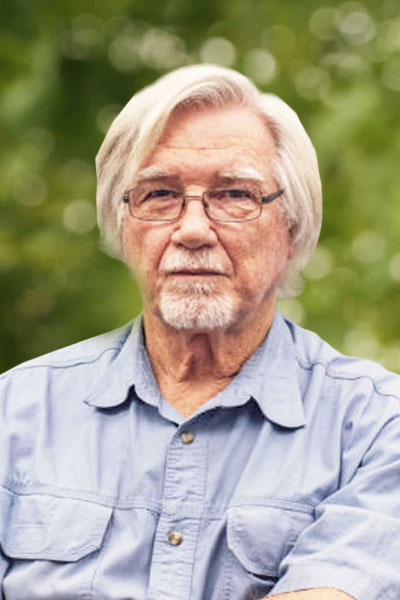John Hodgson
Research Interests
My general interest is in how mammalian movement is accomplished, from the overall limb biomechanics to the neural coordination of muscles and the structural details of muscle which transmit sarcomere activity into the forces and displacements that underly every movement. An additional interest is how altered environments such as in spaceflight and pathologies, such as atrophy impact the normal execution of movement. Most recent work has been in collaboration with Dr. Shantanu Sinha in the Department of Radiology at UCSD (http://radiology.ucsd.edu/about-us/people/faculty/shantanu-sinha) and with Professor J.S. Chen in the Department of Civil Engineering at UCLA (http://www.cee.ucla.edu/faculty/chen/profile). We are investigating how intramuscular structure impacts whole muscle force and displacement. MRI imaging is used to provide muscle structure data and also a pixel-resolution map of intramuscular displacements. Finite element computational models of ‘generic’ muscles have been used to simulate muscle contractions and the intramuscular deformations compared with experimental observations. These efforts indicate that intramuscular morphology, such as fiber pennation angle and elastic properties of intramuscular passive materials have a significant impact on muscle performance. Furthermore, our results suggest specific properties of intramuscular passive materials which will be investigated in the future. We are currently developing a database of subject-specific muscle morphologies using several MRI techniques to image intramuscular fat, connective tissue, muscle fiber pennation angles and intramuscular dynamics of muscle contractions. Parallel efforts are being made to convert the data into subject-specific, image-based computational models in which simulated contractions can be compared with observations of real muscles contracting. Previously document variability in muscle structure will allow us to determine the impact of intramuscular structure on muscle performance. An additional interest is in the degree to which the changes in structure wrought by muscle atrophy contribute to the disproportionate loss of function relative to the loss of muscle mass or cross sectional area. We hope to approach this by conducting studies on muscles before, after and during recovery from atrophy artificially induced by muscle disuse.
Education
Ph.D., Skeletal Muscle Regeneration, University of Bristol 1975
Selected Publications
Sinha S, Shin DD, Hodgson JA, Kinugasa R, Edgerton VR, “Computer-controlled, MR-compatible foot-pedal device to study dynamics of the muscle tendon complex under isometric, concentric, and eccentric contractions”, J Magn Reson Imaging, 36 (2): 498-504 (2012) .
Hodgson JA, Chi SW, Yang JP, Chen JS, Edgerton VR, Sinha S, “Finite element modeling of passive material influence on the deformation and force output of skeletal muscle”, J Mech Behav Biomed Mater, 9 : 163-183 (2012) .
Kinugasa R, Hodgson JA, Edgerton VR, Sinha S, “Asymmetric deformation of contracting human gastrocnemius muscle”, J Appl Physiol, 112 (3): 463-470 (2012) .
Sinha U, Sinha S, Hodgson JA, Edgerton VR, “Human soleus muscle architecture at different ankle joint angles from magnetic resonance diffusion tensor imaging”, J Appl Physiol, 110 (3): 807-819 (2011) .
Kinugasa R, Hodgson JA, Edgerton VR, Shin DD, Sinha S, “Reduction in tendon elasticity from unloading is unrelated to its hypertrophy”, J Appl Physiol, 109 (3): 870-877 (2010) .
Chi SW, Hodgson J, Chen JS, Reggie Edgerton V, Shin DD, Roiz RA, Sinha S, “Finite element modeling reveals complex strain mechanics in the aponeuroses of contracting skeletal muscle”, J Biomech, 43 (7): 1243-1250 (2010) .
Shin DD, Hodgson JA, Edgerton VR, Sinha S, “In vivo intramuscular fascicle-aponeuroses dynamics of the human medial gastrocnemius during plantarflexion and dorsiflexion of the foot”, J Appl Physiol, 107 (4): 1276-1284 (2009) .
Shin D, Finni T, Ahn S, Hodgson JA, Lee HD, Edgerton VR, Sinha S, “Effect of chronic unloading and rehabilitation on human Achilles tendon properties: a velocity-encoded phase-contrast MRI study”, J Appl Physiol, 105 (4): 1179-1186 (2008) .
Kinugasa R, Shin D, Yamauchi J, Mishra C, Hodgson JA, Edgerton VR, Sinha S, “Phase-contrast MRI reveals mechanical behavior of superficial and deep aponeuroses in human medial gastrocnemius during isometric contraction”, J Appl Physiol, 105 (4): 1312-1320 (2008) .
Shin D, Finni T, Ahn S, Hodgson JA, Lee HD, Edgerton VR, Sinha S, “In vivo estimation and repeatability of force-length relationship and stiffness of the human achilles tendon using phase contrast MRI”, J Magn Reson Imaging, 28 (4): 1039-1045 (2008) .
Allan Tobin
Allan Tobin
Professor Emeritus

Email: ajtob@ucla.edu
Office: 2018 TLSB
Phone: (310) 825-5061
Website: http://www.bri.ucla.edu/about-us/past-directors/allantobin
Research Interests
Dr. Tobin’s laboratory uses molecular and cellular techniques to study the function, regulation, and degeneration of GABA-producing neurons in the brain and spinal cord. This work addresses both mechanistic questions and issues of drug development for Huntington’s disease, Parkinson’s disease, epilepsy, and spinal cord injury. In collaboration with Dr. Bruce Dunn in the School of Engineering and Applied Science, Dr. Tobin’s laboratory is also developing biosensors suitable for the detection of neurotransmitter release in real time with high spatial resolution. One project focuses on the two forms of the GABA-synthesizing enzyme, glutamic acid decarboxylase (GAD). The central hypothesis of this work is that the two GADs catalyze the synthesis of distinct pools of GABA, one vesicular and the other cytosolic. According to this model, membrane-associated GAD65 produces vesicular GABA, and cytosolic GAD67 produces cytosolic GABA. While vesicular GABA, released by exocytosis, is likely to be particularly important in point-to-point signaling in synapses, cytosolic GABA, released via plasma-membrane transporters, may serve a longer-range role, inhibiting neuronal activity in limited regions of the nervous system. A novel aspect of this project is the development of biosensors for glutamate and GABA. Another project examines cellular pathogenic mechanisms in Huntington’s disease. The unifying hypothesis of this work is that an expanded polyglutamine tract encoded by the disease-causing allele irreversibly blocks proteasome activity, leading a failure of normal protein turnover and in cell dysfunction and death. A third project examines the plasticity of GABA-producing neurons during recovery from spinal cord injury. Different kinds of rehabilitative training,standing, stepping, and specific motor tasks, have distinctive effects on the pattern of GABA production in the spinal neurons.
Selected Publications
N.J.K. Tillarakaratne, R.D. De Leon, T.X. Hoang, R.R. Roy, V.R. Edgerton, and A.J. Tobin,, “Use-dependent modulation of inhibitory capacity in the feline lumbar spinal cord”, Journal of Neuroscience, 22 : 3130-3143 (2002) .
N.J.K. Tillakaratne, M. Mouria, N.B. Ziv, R.R. Roy, V.R. Edgerton, A.J. Tobin, “Increased expression of glutamate decarboxylase (GAD67) in feline lumbar spinal cord after complete thoracic spinal cord transection”, Journal of Neuroscience Research, 60 : 219-230 (2000) .
K. Thompson, V. Antharam, S. Behrstock, E. Bongarzone, A. Campagnoni, and A.J. Tobin, “Conditionally immortalized cell lines, engineered to produce and release GABA, modulate the development of behavioral seizures”, Experimental Neurology, 161 : 481-489 (2000) .
A.J. Tobin, E. Signer, “Huntington’s disease: the challenge for cell biologists”, Trends in Cell Biology, 10 : 531-536 (2000) .
C. Pinal, and A.J. Tobin, “Uniqueness and redundancy in GABA production”, Perspectives on Developmental Neurobiology, 5 : 109-118 (1998) .
Reggie Edgerton
Reggie Edgerton
Distinguished Professor

Email: vre@ucla.edu
Phone: (310) 825-1910
Website: https://edgertonlab.ibp.ucla.edu/
Research Interests
Two general questions are being studied in my lab. One is, how, and to what extent, does the nervous system control protein expression in skeletal muscle fibers? These studies have shown that although the nervous system has a significant influence on the kind and amount of specific proteins synthesized, there are factors intrinsic to individual fibers that also define these properties. The results show also that the neural influence that is associated with muscle fiber types is probably not mediated via the amount or pattern of activity of the motor units. Whole muscle, single motor units and single muscle fibers are studied physiologically and biochemically. Light and confocal microscopy including quantitative enzyme analyses and immunofluorescent microscopy are some of the experimental methods used to study motor unit plasticity. The principal animal models used are spinal cord injury, spaceflight and surgically induced compensatory hypertrophy. A second, and general question is how the neural networks in the lumbar spinal cord of mammals, including humans, control stepping and how this stepping pattern becomes modified by chronically imposing specific motor tasks on the limbs after complete spinal cord injury. Limb motion, electromyographic and kinetic data are recorded to define locomotor characteristics. These studies have shown that the mammalian spinal cord can learn specific complex motor tasks such as standing and stepping. Studies are conducted with humans with spinal cord injury as well as with laboratory animals. Approach: My lab has a very multidisciplinary and integrative approach to science. It involves techniques to assess the kinetics and kinematics of locomotion, the activation patterns of those motor pools that generate the movement and the segmental and sensory networks that modulate the output of these motor pools. In our experiments we also study cell and tissue properties (nerve and muscle) that are important in generating the behavioral characteristics observed. These analyses consist of enzyme activities of single muscle or neural cells, cell morphology, the kinds of proteins synthesized, the modulations of the mRNA’s of specific myonuclei as well as the physiological properties of the nerve and muscle cells. In short, our studies are designed to define the cellular and subcellular features of tissues that form the basis for the properties of specific movements. We use a variety of experimental perturbations of the neuromuscular system in order to understand its adaptive potential and to define the physiological mechanisms that induce these adaptations. Significance: Our studies have a basic, as well as an applied aspect to them. There are many important, but unanswered questions about the plasticity of the neuromuscular system. Since the neural and the muscular systems are the primary systems that are responsible for the functional features of movement control, it is important to understand how they are defined and how they are modulated to become more or less dysfunctional.
Education
B.S., Physical Education, East Carolina University 1962
M.S., Exercise Physiology, University of Iowa 1963
Ph.D., Exercise Physiology, Michigan State University 1968
Selected Publications
Dy, C., Gerasimenko, Y., Edgerton, V.R., Dyhre-Poulsen, P., Courtine, G., and Harkema, S., “Phase dependent modulation of percutaneously elicited multisegmental muscle responses after spinal cord injury”, J. Neurosci, 103 (5): 2808-2820 (2010) . Gerasimenko, Y., Gorodnichev, R., Machueva, E., Pivovarova, E., Semyenov, D., Savochin, A., Roy, R.R., and Edgerton, V.R., “Novel and direct access to the human locomotor spinal circuitry”, J. Neuroscience, 30 (10): 3700-3708 (2010) . Edgerton, V.R., Roy, R.R., “Spasticity: a switch from inhibition to excitation”, Nat Med, 16 (3): 270-271 (2010) . Tillakaratne, N.J.K., Guu, J.J., de Leon, R.D., Bigbee, A.J., London, N.J., Zhong, H., Ziegler, M.D., Joynes, R.L., Roy, R.R., and Edgerton, V.R., “Functional recovery of stepping in rats after a complete neonatal spinal cord transection is not due to re-growth across the lesion site”, Neuroscience, 166 : 23-33 (2010) . Lee, Y.S., Zdunowski, S., Edgerton, V.R., Roy, R.R., Zhong, H., Hsiao, I, and Lin, V.W., “Improvement of gait patterns in step-trained, complete spinal cord-transected rats treated with a peripheral nerve graft and acidic fibroblast growth factor”, Exp Neurol, 224 (4): 429-437 (2010) . Kinugasa, R., Hodgson, J.A., Edgerton, V.R., Shin, D.D., and Sinha, S., “Reduction in tendon elasticity from unloading is unrelated to its hypertrophy”, J Appl Physiol, 109 (3): 870-877 (2010) . Edgerton, V.R., Harkema, S.J., and Roy, R.R., “Retraining the human spinal cord: Exercise interventions to enhance recovery after a spinal cord injury”, Spinal Cord Medicine Principles and Practice, Second edition, V.W. Lin(Eds.), Chapter 72 : 939-949 (2010) . Ziegler, M.D., Zhong, H, Roy, R.R., and Edgerton, V.R., “Why variability facilitates spinal learning”, J. Neurosci, 30 : 10720-10726 (2010) . Brock, J., Rosenzweig, E., Blesch, A., Moseanko, R., Havton, L., Edgerton, V.R., and Tusynski, M., “Local and remote growth factor effects after primate spinal cord injury”, J. Neurosci, 30 (29): 9728-9737 (2010) . Kim, J.A., Roy, R.R., Kim, S.J., Zhong, H., Haddad, F., Baldwin, K.M. and Edgerton, V.R., “Electromechanical modulation of catabolic and anabolic pathways in chronically inactive, but neurally intact, muscle”, Muscle Nerve, 42 (3): 410-421 (2010) .


